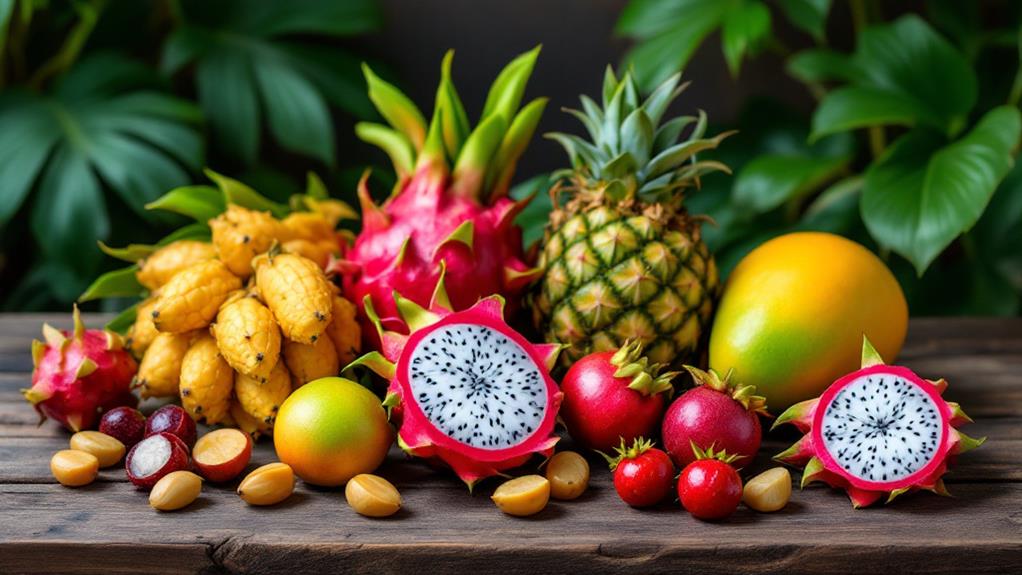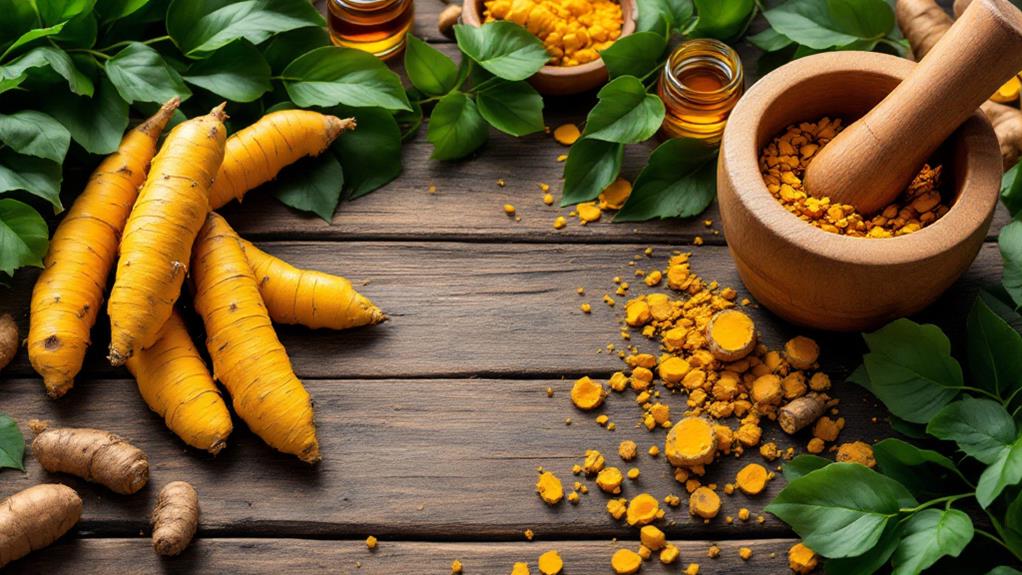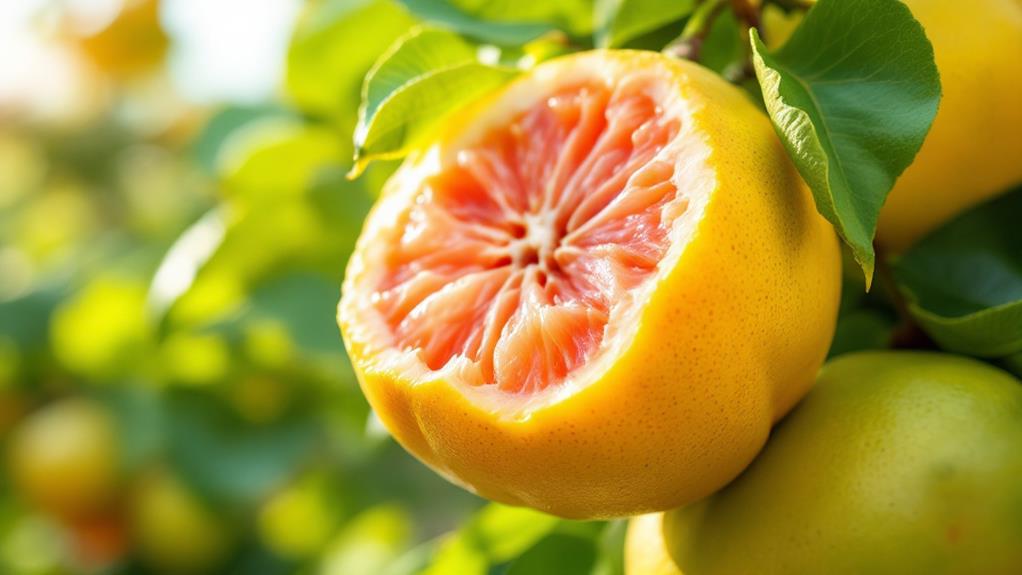Everything You Need to Know About Galangal: A Powerful Healing Root
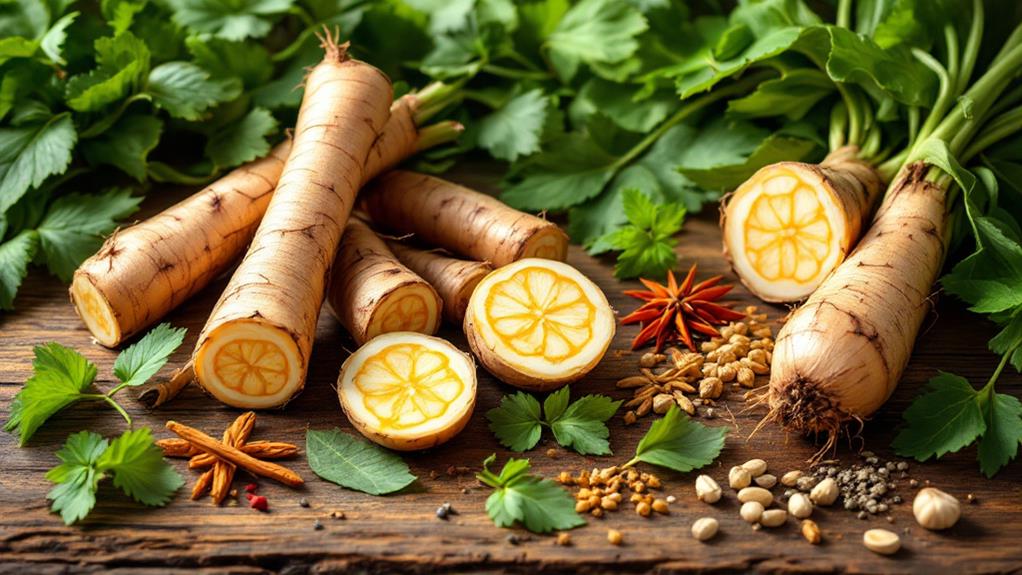
Galangal is a tropical herb you're likely to find in Southeast Asian cuisine, related to ginger and known for its spicy aroma. It's packed with Vitamin C, antioxidants, and minerals like potassium, enhancing your immune system and aiding digestion. This root is celebrated in traditional medicine for its anti-inflammatory and potential cancer-fighting properties. In the kitchen, it boosts dishes like Tom Yum and infuses beverages beautifully. While generally safe, be sure to watch for allergies and consult a healthcare provider if you're pregnant. To fully grasp its diverse benefits and how it could enrich your life, let your curiosity guide you further.
Understanding Galangal
Delving into the world of galangal, you'll uncover a tropical herb that's a staple in Southeast Asian cuisine. This remarkable root, a member of the ginger family, is known for its spicy and aromatic flavor, enhancing dishes with its unique profile. But galangal isn't just about taste; it's also celebrated for its impressive health benefits. The fresh galangal root is a powerhouse of Vitamin C, potassium, and antioxidants, contributing to its status as a prized ingredient in traditional medicine.
Galangal, particularly the greater galangal variety, shares a rich history of medicinal use. It has been employed for centuries in practices from China to Germany, primarily for its anti-inflammatory properties. This quality makes it a natural choice for soothing ailments and promoting general wellness. Users often find relief from digestive issues, as galangal supports digestive health effectively.
Incorporating galangal into your routine offers more than just flavor; it's a step towards embracing a natural approach to health. With its storied past and proven benefits, galangal remains a crucial component of Southeast Asian cuisines and an ally in traditional healing practices. Its robust profile makes it a valuable enhancement to any health-conscious kitchen.
Culinary Uses
In Southeast Asian kitchens, galangal shines as a culinary gem, infusing dishes with its distinct peppery and aromatic qualities. You'll find it prominently featured in Thai food, where it enhances the flavor of soups, curries, and stir-fries. Think of classic dishes like Tom Yum and Tom Kha Gai, where galangal plays a vital role in the curry pastes that define their unique profiles. Its spicy flavour is somewhat akin to ginger, yet it brings its own unmistakable zest.
When you're preparing a dish, fresh galangal can be sliced or minced to release its full flavor. If fresh isn't available, dried and powdered forms can also add a punch to your culinary creations. Beyond food, galangal finds its way into infused beverages, offering a spicy kick to teas. It's often paired with coconut milk, creating a balanced and rich flavor that's both comforting and complex.
Nutritional Profile
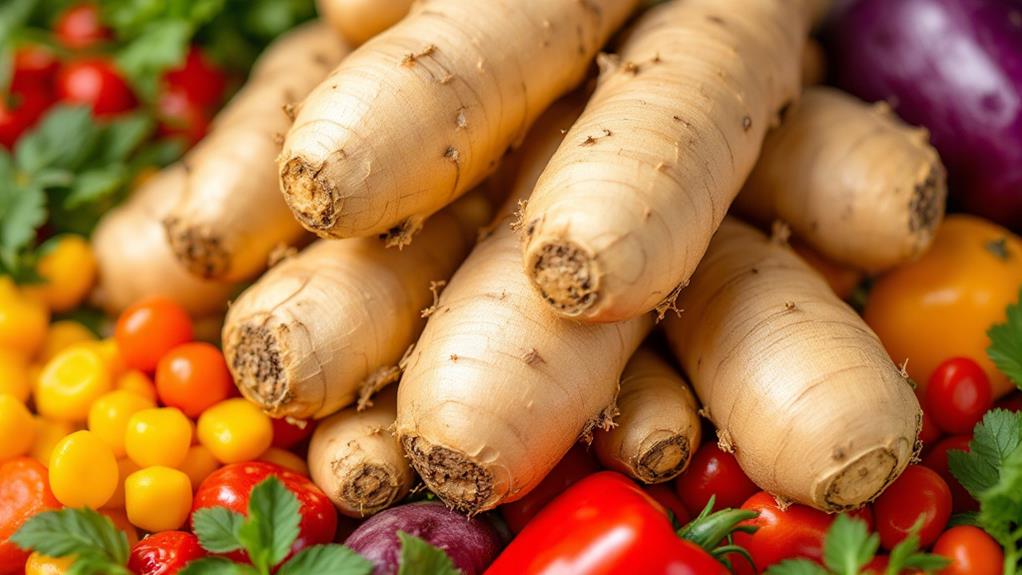
While galangal tantalizes the taste buds with its peppery zest in different dishes, its nutritional profile offers just as much to celebrate. This root is a low-calorie ingredient, boasting only 38 kcal per 100g, which makes it an excellent supplement to diverse diets. With 9.62g of carbohydrates and 1g of dietary fiber per 100g, galangal contributes to digestive health, ensuring your system runs smoothly.
Galangal is rich in Vitamin C, a significant nutrient for enhancing immune function and aiding iron absorption, which supports your general health. But that's not all—this root is packed with an array of fundamental minerals, including potassium, phosphorus, copper, iron, calcium, magnesium, and zinc. Each mineral plays a key role in maintaining bodily functions, from supporting bone health to balancing fluids and aiding in energy production.
Furthermore, galangal contains B vitamins, which are critical for metabolism and regulating your body's energy needs. These vitamins improve the nutritional value of galangal, making it a powerhouse of nutrients. By incorporating galangal into your meals, you're not only adding flavor but also supporting your body's nutritional requirements.
Health Benefits
When you incorporate galangal into your diet, you tap into a wealth of health benefits that this root offers. Rich in antioxidants, particularly polyphenols, galangal helps you combat oxidative stress, lowering your risk of chronic diseases. The active compounds in galangal, such as galangin, have shown potential anti-cancer effects, especially against colon, breast, and pancreatic cancer cells in test-tube studies. This suggests that galangal could be a powerful ally in your quest for better health.
Galangal's anti-inflammatory properties are another reason to contemplate adding it to your meals, as it may alleviate joint pain and help regulate inflammatory markers. Moreover, it supports digestive health by aiding digestion and potentially alleviating gastrointestinal issues, ensuring your digestive system functions smoothly.
Here are some key health benefits of galangal:
- Antioxidants: Rich in polyphenols, galangal fights oxidative stress.
- Cancer: Active compounds like galangin show anti-cancer potential.
- Digestive Health: Helps alleviate gastrointestinal issues.
In addition, if you're concerned about male fertility, studies have indicated that supplementation with galangal can improve sperm motility by 62%. By including galangal in your diet, you welcome a natural approach to improving your comprehensive well-being.
Anti-Inflammatory Properties
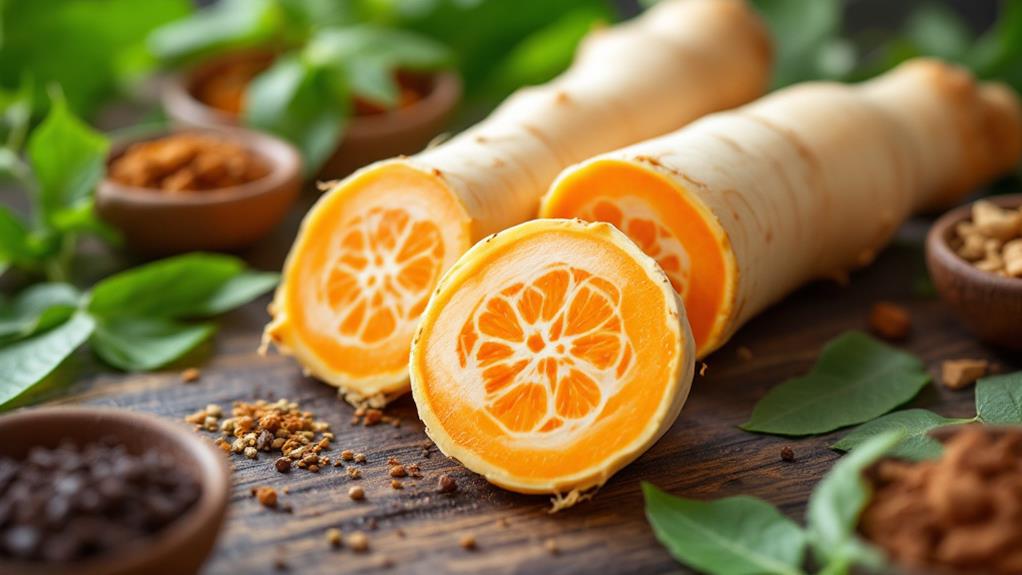
Galangal, thanks to its impressive anti-inflammatory properties, stands out as a natural remedy for inflammation-related issues. If you're dealing with joint pain or inflammation, galangal might be your go-to solution. It contains galangin, a compound known for its ability to modulate key inflammatory pathways like ERK and NF-κB. This modulation can markedly reduce inflammation, providing relief for conditions such as osteoarthritis.
The healing power of galangal lies in its high polyphenol content, which plays a vital role in regulating inflammatory markers. These polyphenols not only aid in reducing joint pain but also support your general immune health, making it an extensive therapeutic option. Animal studies have shown that galangal extracts can lower inflammation and oxidative stress, hinting at their potential for treating chronic inflammatory diseases.
For centuries, traditional medicine has harnessed galangal's anti-inflammatory properties to address numerous ailments. This long-standing use reinforces its reputation as a natural anti-inflammatory agent. By integrating galangal into your routine, you may find relief from inflammation-related discomforts, embracing a natural path to healing and improved well-being. So, why not consider this powerful root for its therapeutic benefits?
Antioxidant Effects
Galangal's rich antioxidant properties make it a formidable ally in combatting oxidative stress and reducing cellular damage. This powerful healing root, particularly Alpinia officinarum, boasts strong antioxidant activity thanks to its abundant polyphenols. These compounds are significant in neutralizing free radicals, which can otherwise wreak havoc on your cells and increase the risk of chronic diseases like heart disease and cancer.
Incorporating galangal into your diet can offer several benefits:
- Improved metabolic health: Antioxidants in galangal help stabilize your body's metabolic processes, contributing to general well-being.
- Reduced oxidative stress: Like its relative ginger, galangal may lower malondialdehyde levels, a marker of oxidative stress, especially in conditions like diabetes.
- Defense against chronic diseases: By reducing cellular damage, galangal's antioxidants could lower the risk of heart disease and cancer.
Regular consumption of galangal may boost your body's defense mechanisms, making it an important component of your wellness routine. Its high antioxidant content not only protects your cells but also supports longevity. By actively combatting oxidative stress, galangal helps you maintain better health and energy, reinforcing its status as a powerful healing root.
Cancer-Fighting Compounds
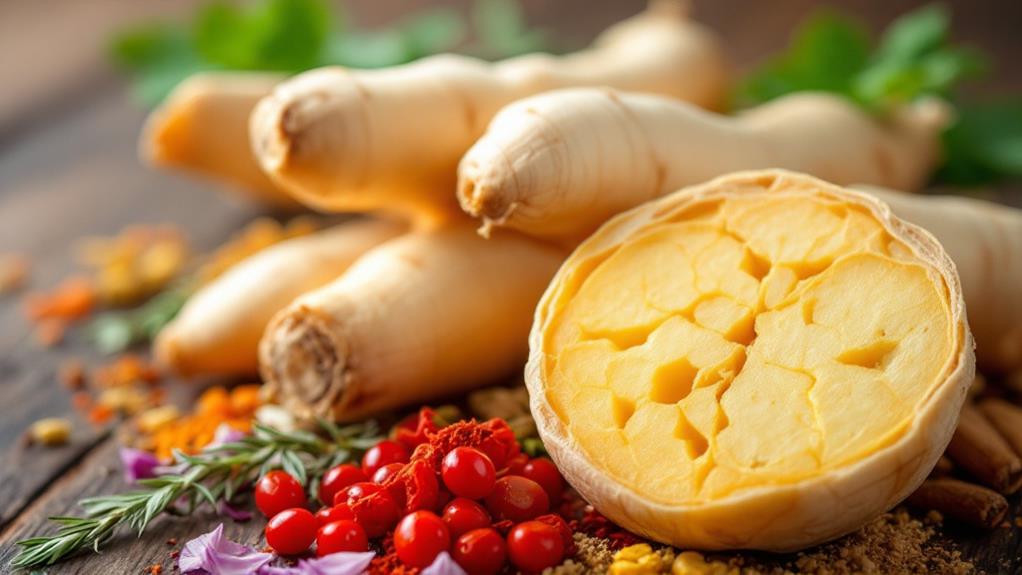
Releasing its potential as a natural remedy, galangal harbors cancer-fighting compounds that are garnering scientific interest. This healing root contains galangin, a powerful flavonoid exhibiting promising anti-cancer effects. In test-tube studies, galangin has shown remarkable potential against melanoma, pancreatic, and colon cancer cells. For human colon cancer, galangin induces apoptosis by causing mitochondrial dysfunction and activating caspase-dependent pathways, marking it as a significant candidate in cancer treatment.
Additionally, diarylheptanoids extracted from galangal have demonstrated their prowess by suppressing the proliferation of pancreatic cancer cells. These findings highlight galangal's potential as an anti-cancer agent within the domain of herbal medicine. The antiproliferative activities of lesser galangal also extend to acute monocytic leukemia, showcasing its efficacy in combating certain blood cancers.
While the findings are promising, further research is essential to validate the cancer-fighting properties of galangal in human clinical trials. As science explores deeper into understanding this healing root, its role in cancer prevention and treatment could become more pronounced. Galangal's compounds may soon offer a natural, complementary approach in the ongoing battle against cancer cells.
Reproductive Health Benefits
Among the many health benefits of galangal, its impact on reproductive health stands out considerably. This powerful root has shown promise in enhancing male fertility, primarily due to a compound called HMP. Animal studies point to improved sperm count and motility. In human studies, galangal supplementation has been linked to a 62% increase in sperm motility, making it a potential ally for male reproductive health.
The phytochemical properties of galangal play an essential role in this process. By modulating inflammation and amplifying immune system function, galangal may support comprehensive reproductive health. Traditional medicine has long used galangal to tackle reproductive issues, though these uses require further scientific validation.
When incorporating galangal into your diet to support male fertility, it's important to be mindful of a few key points:
- Dosage: Confirm you're following recommended amounts to avoid adverse effects.
- Potential Interactions: Check for any interactions with existing medications you might be taking.
- Holistic Approach: Consider galangal as part of a broader fertility treatment plan.
Understanding these aspects can help you make the most of galangal's reproductive health benefits while minimizing any risks.
Precautions and Side Effects
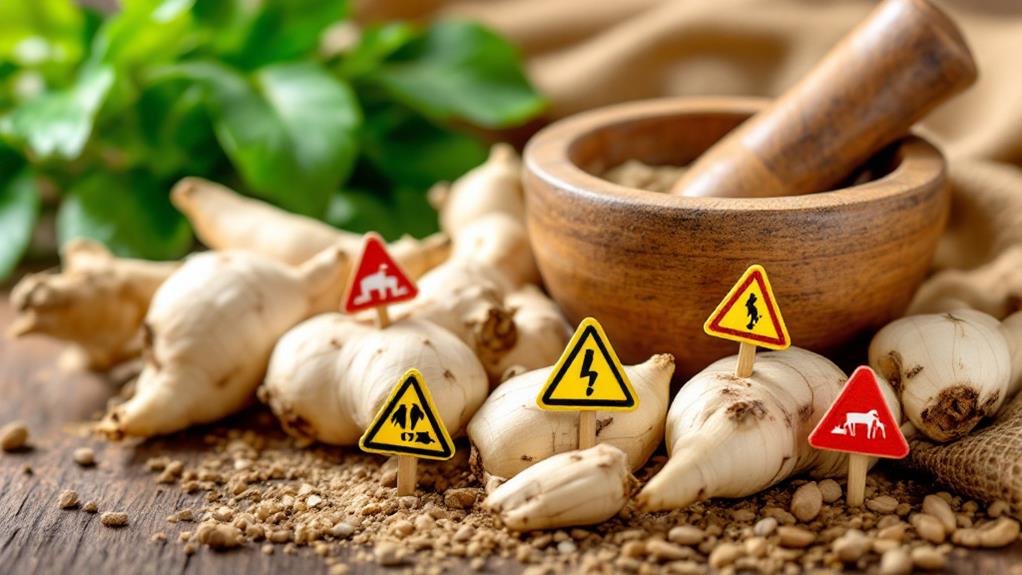
While galangal offers promising benefits for reproductive health, it's also important to be aware of its precautions and potential side effects. Generally, galangal is safe when consumed in food amounts, but problems can arise with high doses and concentrated forms. In animal studies, high doses of galangal have led to serious side effects, including coma and even death. The lack of information on safe dosages for galangal supplements underscores the significance of caution, especially when experimenting with concentrated forms.
For some, allergic reactions are a concern, particularly if you're sensitive to plants in the Zingiberaceae family, which includes ginger. If you experience any signs of an allergy, such as itching or swelling, avoid galangal. Pregnant women and those breastfeeding should be careful, as there's insufficient research on its effects during these important periods, making consultation with healthcare providers critical before use.
Additionally, galangal can interact with certain medications. If you're currently on prescription drugs, be sure to discuss with your doctor before incorporating galangal into your routine. This step is essential to prevent unwanted medication interactions and guarantee your health remains a top priority.
Preparation and Storage
In the case of preparing and storing galangal, proper techniques guarantee you get the most out of this flavorful root. Start with fresh galangal for the best results. To improve flavor distribution, slice or mince the root, as it can be tough and fibrous. Once prepped, consider the best storage methods to maintain quality and prevent spoilage.
For short-term storage, keep fresh galangal in the refrigerator. Place it in an airtight container to shield it from moisture and air exposure, assuring it stays fresh for up to two weeks. If you're looking for longer storage options, freezing is an excellent choice. Puree the galangal and store it in the freezer, where it can remain fresh for several months.
To maintain its quality over time, consider vacuum sealing the galangal before freezing. This prevents freezer burn and keeps the root in top condition. Here are some quick tips:
- Refrigeration: Use an airtight container for up to two weeks.
- Freezing: Puree the root and vacuum seal to extend freshness.
- Dried Storage: Keep in a cool, dark place in an airtight container.
These methods guarantee your galangal retains its unique flavor and potency.

